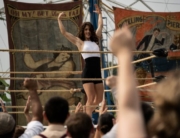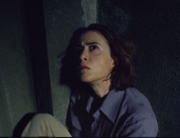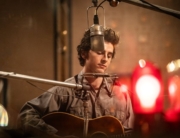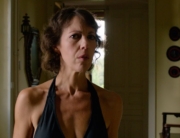
Keira Knightley and MIchael Fassbender in A DANGEROUS METHOD (Sony Pictures Classics)
Directed by David Cronenberg
Produced by Jeremy Thomas
Written by Christopher Hampton, based on his play The Talking Cure, and the book A Most Dangerous Method: The Story of Jung, Freud, and Sabina Spielrein by John Kerr
Released by Sony Pictures Classics
UK/Germany/Canada/Switzerland. 99 min. Rated R
With Keira Knightley, Viggo Mortensen, Michael Fassbender, Sarah Gadon & Vincent Cassel
Talking is what’s dangerous in A Dangerous Method when it takes place among the pioneers who first realize a cigar is never just cigar. They tell each other their dreams, fantasies, emotions, and compare themselves to mythic figures—freeing them to act as if they were.
It certainly doesn’t seem like talking could help 18-year-old Sabina Spielrein (Keira Knightley) when she’s driven to a Zurich clinic in 1904. She’s in the full-fledged grip of hysteria, the mysterious condition that particularly struck young, middle-class, educated women with explosive behavior and contorted limbs. Her Russian parents have in desperation sought out the new treatment of Dr. Carl Jung (Michael Fassbender). As wild as Knightley behaves, she matches period photographs of such patients, which makes it astounding that after just a couple of months of the doctor listening to her, her condition significantly ameliorates. With Jung sitting behind her, she can release the most intimate memories from her abusive childhood, her associations with sex and bodily functions, and how it all still stimulates her. She not only becomes his most renowned and cited (anonymously) patient, but also his research assistant. She even sympathetically analyzes his frequently pregnant wife (Sarah Gadon), who feels pressured to produce a son.
As Spielrein continues to be Jung’s intellectual muse and erotic temptation, she adoringly follows his steps into medical school. His reports on her successful recovery help to win him anointment by the older Sigmund Freud (Viggo Mortensen) as his heir apparent in psychoanalysis. Through a series of extensive, meticulously recreated meetings in Vienna over the next decade, the men rigorously debate their evolving understanding of the human psyche while strolling the grounds of formal gardens, smoking pipes in Freud’s increasingly cluttered study, and around Freud’s family dinner table. The charisma of the actors within these repeating settings helps communicate the escalating tensions in their changing relationship, though their theoretical differences become a bit esoteric to follow.
Into the hothouse of the freeing force of the unconscious, where everyone seems to be analyzing each other’s dreams, Freud in 1908 temporarily hands off to Jung a match to stir the embers. An embarrassment to the fledgling profession, the drug-addicted Otto Gross (Vincent Cassel, roaring through his portrayal) is a fellow psychiatrist who seems like he’s arrived in a time machine from the 1960s. He cogently, yet madly, argues for mind-expanding drugs and acting on all desires and fantasies, particularly between doctor and patient (and he is not a fictional figure). As Jung’s patient, he convinces his doctor to break the shackles of monogamy. Jung’s resulting affair with Spielrein was only pieced together when her professional papers, diaries, and letters to and from Freud and Jung were found in different cities more than 70 years later—not that she was Jung’s last mistress.
Director David Cronenberg uses this historical evidence that was brought together by psychologist John Kerr in A Most Dangerous Method: The Story of Jung, Freud, and Sabina Spielrein to presume that Jung and Spielrein unleashed all their fantasies in bed together (however, their very unrepressed couplings do seem extreme). Whatever the ethics or psychological issues, their passion lends credence to her fury as a woman later scorned. It also emphasizes how Jung vociferously lied about the relationship to save his career and marriage. His wife, with her family wealth, subsidized his work and comfortable lifestyle, complete with a yacht for a birthday gift.
In addition to their financial distinctions, their generational and ethnic differences are clearly shown to influence their feelings and motivations. Freud appreciates having a prestigious protégé, particularly a non-Jewish Swiss, and Sabina obsessively sees Jung as the Aryan hero Siegfried. She is determined they should embody Wagnerian myths together, where she is the sacrificing heroine whose love helps him change the world in a blaze of glory. While she influences his interpretations of culture and symbolism, Jung is convinced her and Freud’s Jewishness explains their psychological make-up.
In adapting his play The Talking Cure, scriptwriter Christopher Hampton reduces the climax of his first act, which flashes forward to her 1941 murder by Nazis back in Russia, to the final scroll of subsequent biographical information of the protagonists. The film instead builds up more and more around Jung’s fervent conviction that he is clairvoyant. He foresees dark clouds over Europe and sinks into a deep depression with the beginning of World War I. It will be the end of the world as they know it, yet these very flawed, very bold innovators continue to influence the 21st century world.






Good review. The performances are good, even though Knightley may be over-acting quite a bit, and it looks great, but the film also just feels like a series of vignettes with no real feeling or drama to it. Basically what I’m trying to say was that I was bored and this story just never really got off the ground. Check out my review when you get the chance.
You’re mostly looking at the entertainment value, but Cronenberg’s insights into the historical and social context may be more important to the film, and for it to find its audience.